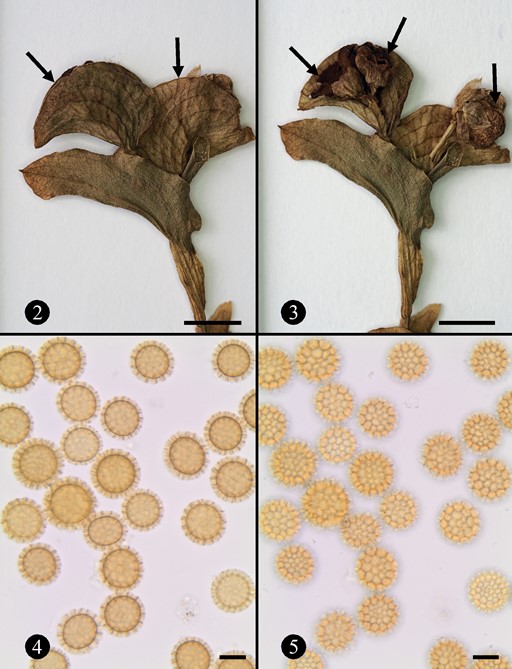Kalmanago commelinae (Kom.) Denchev, T. Denchev, Kemler & Begerow, comb. nov.
MycoBank number: MB 557799; Index Fungorum number: IF 557799; Facesoffungi number: FoF; Figs 2–5
Basionym: Tilletia commelinae Kom., in Jaczewski, Komarov & Tranzschel, Fungi Rossiae Exsicc.: no. 210, 1899.
≡ Ustilago commelinae (Kom.) Zundel, Contr. Dept. Bot. School Agric. Pennsylvania State Coll. 176: 151, 1953.
≡ Bauerago commelinae (Kom.) Denchev, Mycotaxon 87: 128 [in the journal, printed by error as ‘129’], 2003.
Typification — On Commelina communis: CHINA, JILIN PROVINCE, near Yalu River, not far from Mao-erh-shan (currently Linjiang), 3 Sep 1897, leg. V. Komarov, s.n. (LE 43546, lectotype, designated here; IF 557800). Isolectotypes in Jaczewski, Komarov & Tranzschel, Fungi Rossiae Exsiccati, no. 210 (as ‘Tilletia? commelinae’).Fig. 6
Infection systemic. Sori destroying the seeds, filling the hypertrophied capsules with a powdery, umber (based on the Rayner’s Colour Chart; Rayner 1970) spore mass; enclosed by the spatha. Spores subglobose, globose or broadly ellipsoidal, sometimes ellipsoidal, ovoid or slightly irregular, (14.5–)15.5–20.5(–21.5) × (13.5–)14.5–19(–20) (18.4 ± 1.0 × 16.8 ± 1.1) μm (n/2 = 200), medium yellowish brown to medium reddish brown, reti- culate; spore wall (1.9–)2.2–3.3(–3.6) μm thick (including reticulum); meshes 4–7 per spore diameter, polyhedral or irregular, (0.7–)1.0–4.0(–4.5) μm long; muri 19–28 on equatorial circumference, in optical median view acute or subacute, (1.0–)1.2–2.3(–2.7) μm high. Spore germination (after Duran & Safeeulla 1968; Ingold 1989b) results in two-celled phragmobasidium; basidium cells neither fuse nor form sporidia; each cell developing a long, unbranched hypha; lower cell producing a hypha near the septum, upper cell producing hyphae either in an apical position or just above the septum, but never in an intermediate position.
Specimens examined – On Commelina communis L.: JAPAN, AOMORI PREFEC- TURE, Hirosaki, Bunkyo-cho, Campus of Hirosaki University (Faculty of Agriculture and Life Science), 40°35ʹN 140°28ʹE, 26 Oct 1999, leg. C.M. Denchev & Y. Harada, s.n. (SOMF 30251); Hirosaki, 23 Oct 1999, leg. C.M. Denchev, s.n. (SOMF 30249).
Known hosts — On Commelinaceae: Commelina communis.
Distribution — Asia (Russian Far East, Japan, China), North America (U.S.A.).
Comments — Commelina communis is native to East and South East Asia, and introduced into East and South Europe and North America (Komarov 1901; Hong & DeFilipps 2000). Kalmanago commelinae is reported (as ‘Tilletia commelinae’, ‘Ustilago commelinae’ or ‘Bauerago commelinae’) from the Russian Far East – Ussuri Region (Govorova 1990; Azbukina et al. 1995); Japan – Hokkaido (incl. Okushiri Island) and Honshu (Aomori, Akita, Iwate, Ibaraki, and Shizuoka prefectures) (Sydow & Sydow 1913; Ito 1936; Kakishima 1982; Harada 1983, 1984; Vánky 1986, 1987, 1994); China (Jaczewski et al. 1899b; Guo 1988, 2000; Vánky 1992, 1994); and North America (Durán & Fischer 1961; Vánky 1994; Farr & Rossman 2020).
Nomenclatural notes — The name of this smut fungus was published by Komarov as ‘Tilletia? commelinae’, and the species was distributed in the exsiccate series Jaczewski, Komarov & Tranzschel, Fungi Rossiae Exsiccati, under no. 210 (Jaczewski et al. 1899a, b). Although assigned to Tilletia with a question mark, this species was accepted by Komarov and he provided it with a description. Therefore, T. commelinae is considered as a validly published name (Art. 36.1., Shenzhen Code).
In volume 87 of Mycotaxon, pages 128 & 129 were inverted by the journal printer, incorrectly numbered, and in the wrong page order. Both combinations published there, B. commelinae and B. combensis, are, for nomenclatural purposes, to be considered as having been published on page 128. Three other species on hosts in the Commelinaceae, hitherto placed in Bauerago, also need to be relocated to Kalmanago.

Figs 2–5. Kalmanago commelinae on Commelina communis (SOMF 30251). 2, 3. Habit (arrows in 2 show the spathae enclosing sori; arrows in 3 indicate infected capsules, visible after partial removal of the spathae). 4, 5. Spores in LM (in median and surface view, respectively). Scale bars: 2, 3 = 0.5 cm, 4, 5 = 10 μm

Fig. 6. Kalmanago commelinae on Commelina communis (lectotypus)
